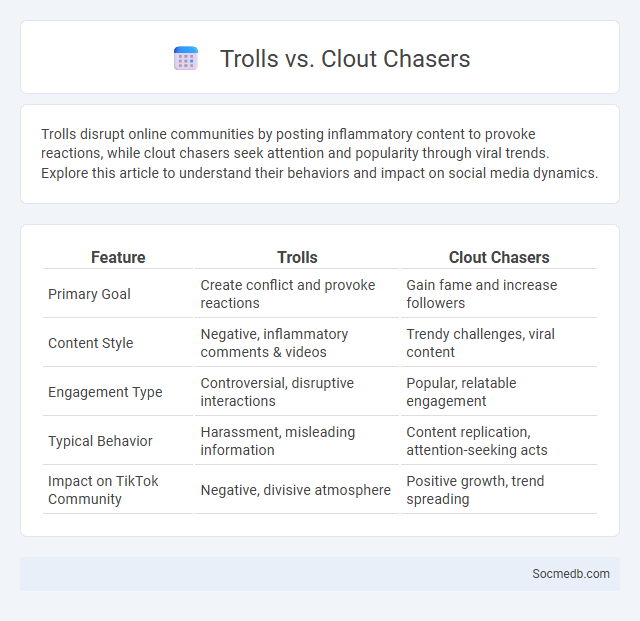
Photo illustration: Trolls vs Clout Chasers
Trolls disrupt online communities by posting inflammatory content to provoke reactions, while clout chasers seek attention and popularity through viral trends. Explore this article to understand their behaviors and impact on social media dynamics.
Table of Comparison
| Feature | Trolls | Clout Chasers |
|---|---|---|
| Primary Goal | Create conflict and provoke reactions | Gain fame and increase followers |
| Content Style | Negative, inflammatory comments & videos | Trendy challenges, viral content |
| Engagement Type | Controversial, disruptive interactions | Popular, relatable engagement |
| Typical Behavior | Harassment, misleading information | Content replication, attention-seeking acts |
| Impact on TikTok Community | Negative, divisive atmosphere | Positive growth, trend spreading |
Understanding Trolls: Definition and Motives
Trolls are individuals who deliberately provoke, disrupt, or manipulate conversations on social media platforms to elicit emotional responses or create chaos. Understanding the motives behind trolling, such as seeking attention, expressing frustration, or influencing opinions, helps you develop effective strategies to manage and mitigate harmful interactions. Recognizing these patterns enables users to maintain healthier online environments and protect their digital well-being.
What Drives Clout Chasers Online?
Clout chasers online are driven by the desire for social validation, seeking likes, shares, and followers as measures of influence and popularity. The dopamine hit from engagement metrics fuels their behavior, motivating them to create eye-catching, often provocative content to maximize visibility. Your awareness of these psychological triggers can help you navigate social media more mindfully and avoid getting caught in the cycle of chasing fleeting digital approval.
Comparing Tactics: Trolls vs Clout Chasers
Trolls leverage provocative and inflammatory content to incite negative reactions and disrupt online communities, often hiding behind anonymity to avoid accountability. Clout chasers, in contrast, strategically create viral and attention-grabbing content to boost their social media presence and follower count, prioritizing engagement metrics over authenticity. While trolls thrive on chaos and controversy, clout chasers focus on visibility and popularity through trend exploitation and influencer collaboration.
Psychological Profiles: Trolls and Clout Chasers
Social media platforms are frequently invaded by trolls, individuals who intentionally provoke others by posting inflammatory or offensive content to disrupt conversations and garner reactions. Clout chasers, on the other hand, strategically share sensational or trending content to boost their visibility and follower count, often valuing popularity over genuine interaction. Understanding these psychological profiles helps you navigate online spaces more effectively and maintain a healthier digital experience.
Impact on Online Communities
Social media platforms have transformed online communities by facilitating real-time interaction and fostering diverse interest groups. These virtual spaces enable users to share information rapidly, support each other, and build collective identities across geographic boundaries. However, the prevalence of misinformation and echo chambers challenges community cohesion and trust within these digital networks.
Social Media Algorithms and the Rise of Trolls & Clout Chasers
Social media algorithms prioritize engaging content by amplifying posts with high interaction rates, often leading to increased visibility for trolls and clout chasers who exploit sensationalism and controversy. These algorithms optimize for user retention by promoting polarizing or emotionally charged material, inadvertently fueling the spread of misinformation and toxic behavior. Platforms like Twitter, Facebook, and TikTok continually refine their algorithms, yet the challenge remains to balance user engagement with healthier online discourse.
How to Identify Trolls and Clout Chasers
Recognizing social media trolls involves spotting users who deliberately provoke or offend others with inflammatory comments, repetitive negative posts, or personal attacks designed to disrupt conversations. Clout chasers can be identified by their frequent attempts to gain attention through exaggerating achievements, tagging unrelated popular accounts, or jumping on trending topics without genuine interest. Monitoring behaviors such as posting controversial opinions solely for engagement, excessive self-promotion, and inconsistent content authenticity helps distinguish between genuine users, trolls, and clout chasers.
Real-World Consequences: From Virality to Vulnerability
Social media virality can rapidly amplify your message, but it also escalates exposure to criticism, misinformation, and privacy breaches. The psychological impact of online attention ranges from increased anxiety to diminished self-esteem, influencing real-world mental health. Understanding these dynamics helps you navigate digital spaces safely, balancing visibility with vulnerability.
Strategies for Dealing with Trolls and Clout Chasers
Effective strategies for dealing with trolls on social media include ignoring inflammatory comments, using platform-specific blocking and reporting tools, and fostering positive community engagement to reduce toxic behavior. Managing clout chasers requires setting clear boundaries, limiting personal information shared, and focusing on authentic interactions rather than popularity metrics. Employing these tactics helps maintain a healthy online environment and protects mental well-being.
Building Resilient Digital Communities
Building resilient digital communities on social media involves fostering trust, promoting inclusive dialogue, and implementing robust moderation tools to counter misinformation and harassment. Platforms that invest in user education, transparent policies, and adaptive algorithms can strengthen community bonds and ensure safe, diverse interaction spaces. Emphasizing mental health resources and digital literacy further enhances the capacity of online communities to withstand challenges and thrive sustainably.
 socmedb.com
socmedb.com